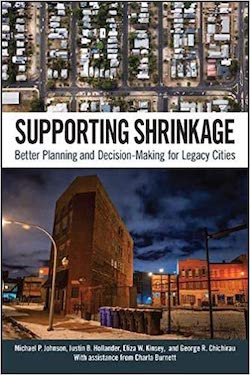An excerpt from "Supporting Shrinkage: Better Planning and Decision-Making for Legacy Cities," written by Michael P. Johnson, Justin B. Hollander, Eliza W. Kinsey, and George R. Chichirau and published by SUNY Press.

Urban shrinkage has been the subject of extensive attention within the planning community, especially so in light of recent projections that global population will soon reach sustained decline. In the United States, a relatively large number of cities and regions have experienced increased distress over the past two decades, according to measures relating to population and economic decline, or vacant and abandoned housing. But with overall immigration on the wane and birthrates at record low levels, the problems associated with falling populations have suddenly become a concern for planners everywhere. Population decline can significantly reduce the quality of life for residents: extreme examples include severely degraded infrastructure in Flint, MI and social unrest in Baltimore, MD.
The following collection of excerpts, mostly from the book's first chapter, are reprinted with permission of the authors and the publisher.
Hope for Shrinking Cities
 The good news is that there are opportunities to address municipal decline issues by using tools of planning and policy design that take advantage of recent innovations in data analytics and information technology. We are talking about prospective and prescriptive analyses. These are intended to provide stakeholders with specific, evidence-based responses using principles of decision sciences applied to spatial data. These responses are rooted in principles of inclusion, engagement, empowerment, and advocacy with, by, and for localized and traditionally underrepresented communities. In our new book Supporting Shrinkage: Better Planning and Decision-Making for Legacy Cities (SUNY Press), we present, with our co-authors, promising examples of data-driven decision making for shrinking cities and distressed communities, and hint at new applications that can leverage data and technology for greater positive impacts. We argue that decisions informed by qualitative and quantitative data and analytic methods, implemented through accessible and affordable technologies, and based on notions of social impact and social justice, can enable residents to play a leading role in the positive transformation of their distressed communities.
The good news is that there are opportunities to address municipal decline issues by using tools of planning and policy design that take advantage of recent innovations in data analytics and information technology. We are talking about prospective and prescriptive analyses. These are intended to provide stakeholders with specific, evidence-based responses using principles of decision sciences applied to spatial data. These responses are rooted in principles of inclusion, engagement, empowerment, and advocacy with, by, and for localized and traditionally underrepresented communities. In our new book Supporting Shrinkage: Better Planning and Decision-Making for Legacy Cities (SUNY Press), we present, with our co-authors, promising examples of data-driven decision making for shrinking cities and distressed communities, and hint at new applications that can leverage data and technology for greater positive impacts. We argue that decisions informed by qualitative and quantitative data and analytic methods, implemented through accessible and affordable technologies, and based on notions of social impact and social justice, can enable residents to play a leading role in the positive transformation of their distressed communities.
The Baltimore Experience
As the U.S. was emerging from the Great Recession in 2013, Maryland received $550 million from the General Mortgage Servicing settlement of a lawsuit against the nation’s five largest mortgage servicers for abuses associated with foreclosure abuses, fraud, and unethical mortgage servicing practices (Maryland Attorney General, undated). The city of Baltimore used $10 million of these funds to support efforts towards acquisition and demolition of 4,000 blighted properties, resident relocation and homeowner down payment assistance under the Vacants to Value (V2V) program.
To gain insight into the process by which planners decided which vacant properties to acquire and demolish, our research team used a Community-Based Operations Research approach to develop a computer model to model the values that the city’s team brought to their task and then interviewed them about their decision-making.
We learned that the overriding concern for planners was the level of distress across the neighborhoods, and the primary decision-making conflict was between targeting money toward revitalizing one area versus spreading the funds more equitably across the city emerged as a theme within the development of action plans while working with a limited budget. Some City officials expressed the opinion that targeting funds in a more strategic manner would have a larger impact, while others emphasized the importance and political necessity of the equitable distribution of demolition dollars across the city.
Based on the interviews we conducted, the City’s criteria for this selection process seemed to center around the themes of blight elimination, neighborhood stability, support of existing redevelopment efforts, large-scale demolition, targeted investment, and equal distribution of funds across the city. Using decision modeling methods, we generated a range of vacant parcel re-use strategies that balance competing objectives and provide planners with multiple development alternative strategies that provide a basis for conversations with community stakeholders.
Lessons for Supporting Shrinkage
The development of a model for improving decision-making in Baltimore (and elsewhere) proved key and can be more broadly generalized to other communities addressing shrinkage. Decisions regarding housing and community development informed by analytic planning models, and planning support systems based on these models, can and should reflect the perspectives of multiple stakeholders, facilitate active participation across diverse groups, address a wide variety of active and passive land uses, and be rooted in principles of inclusion, engagement, empowerment, and advocacy. Such planning methods and technologies have the potential to transform our notion of what more widely available data and smart cities can do with and for shrinking cities, declining regions, and distressed communities. But for shrinking cities to take advantage of these methods, they will need a commitment to community engagement, good governance, and appropriate technical expertise.
Michael P. Johnson, PhD, is professor and chair of the Department of Public Policy and Public Affairs at University of Massachusetts Boston.
Justin B. Hollander, PhD, FAICP, is a professor in the Department of Urban and Environmental Policy and Planning at Tufts University.
 Supporting Shrinkage: Better Planning and Decision-Making for Legacy Cities
Supporting Shrinkage: Better Planning and Decision-Making for Legacy Cities
Michael P. Johnson, Justin B. Hollander, Eliza W. Kinsey, and George R. Chichirau
SUNY Press
276 Pages

Alabama: Trump Terminates Settlements for Black Communities Harmed By Raw Sewage
Trump deemed the landmark civil rights agreement “illegal DEI and environmental justice policy.”

Planetizen Federal Action Tracker
A weekly monitor of how Trump’s orders and actions are impacting planners and planning in America.

The 120 Year Old Tiny Home Villages That Sheltered San Francisco’s Earthquake Refugees
More than a century ago, San Francisco mobilized to house thousands of residents displaced by the 1906 earthquake. Could their strategy offer a model for the present?

In Both Crashes and Crime, Public Transportation is Far Safer than Driving
Contrary to popular assumptions, public transportation has far lower crash and crime rates than automobile travel. For safer communities, improve and encourage transit travel.

Report: Zoning Reforms Should Complement Nashville’s Ambitious Transit Plan
Without reform, restrictive zoning codes will limit the impact of the city’s planned transit expansion and could exclude some of the residents who depend on transit the most.

Judge Orders Release of Frozen IRA, IIJA Funding
The decision is a victory for environmental groups who charged that freezing funds for critical infrastructure and disaster response programs caused “real and irreparable harm” to communities.
Urban Design for Planners 1: Software Tools
This six-course series explores essential urban design concepts using open source software and equips planners with the tools they need to participate fully in the urban design process.
Planning for Universal Design
Learn the tools for implementing Universal Design in planning regulations.
Jessamine County Fiscal Court
Caltrans
Institute for Housing and Urban Development Studies (IHS)
City of Grandview
Harvard GSD Executive Education
Toledo-Lucas County Plan Commissions
Salt Lake City
NYU Wagner Graduate School of Public Service





























